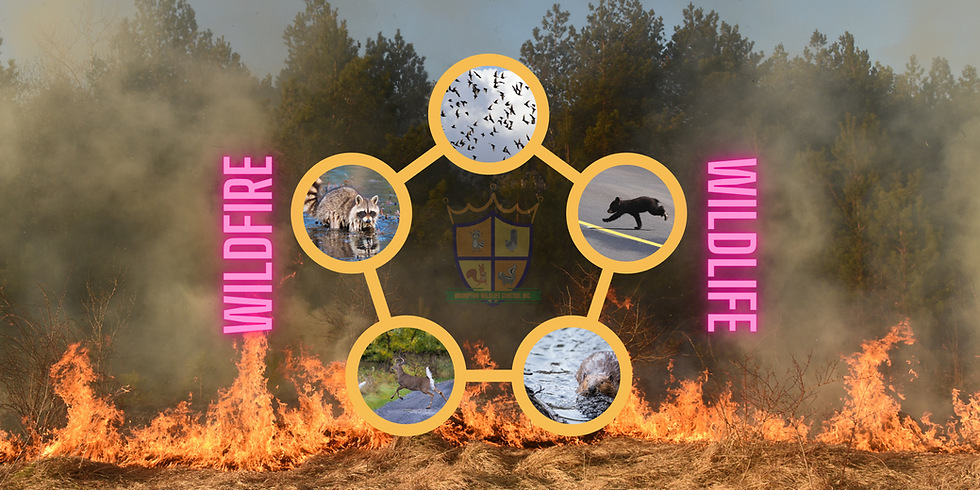UK's Rarest Wildlife: The Devastating Impact Of Wildfires

Table of Contents
Habitat Loss and Fragmentation: The Primary Impact of Wildfires
Wildfires are a catastrophic event for many habitats crucial to the survival of the UK's rarest wildlife. The intense heat destroys vital vegetation, leaving behind barren landscapes unsuitable for many species. This habitat loss is arguably the most significant impact of wildfires, directly impacting the ability of these species to survive and thrive.
- Heathland: These unique ecosystems, home to specialist insects like the heath fritillary butterfly and reptiles such as the smooth snake, are highly flammable and easily devastated by fire.
- Peat bogs: These vital carbon sinks, supporting rare plants like the bog cotton and providing habitat for the elusive large heath butterfly, are particularly vulnerable due to their peat's highly combustible nature.
- Woodlands: Ancient woodlands, rich in biodiversity and supporting rare birds such as the woodlark and the nightjar, can suffer severe damage from wildfires, resulting in significant habitat loss and fragmentation.
- Caledonian pine forests: These iconic forests, home to the magnificent capercaillie and the crested tit, are particularly susceptible to wildfire, with the potential for devastating long-term consequences for these already endangered species.
- Coastal sand dunes: Crucial breeding grounds for the natterjack toad and other rare invertebrates, coastal dunes are threatened by wildfires that can destroy nesting sites and disrupt delicate ecological balances.
Habitat fragmentation, a consequence of wildfire, further exacerbates the problem. The remaining patches of habitat become isolated, hindering animal movement, gene flow, and ultimately leading to smaller, less resilient populations more vulnerable to disease and environmental changes. This contributes significantly to the risk of species extinction.
Direct Mortality of UK's Rarest Wildlife
Wildfires cause direct mortality among the UK's rarest wildlife through several mechanisms. The intense heat of the flames directly kills animals, while smoke inhalation causes respiratory distress and death. Even animals that escape the immediate flames can succumb to heat stress.
- Slow-moving reptiles: Species like adders and slow worms, with their limited mobility, are particularly vulnerable, easily overtaken by the advancing flames.
- Ground-nesting birds: These birds, including species like the nightjar and the curlew, lose their nests, eggs, and chicks to wildfires.
- Insects and invertebrates: Many rare insect species, whose life cycles are tied to specific plants, are decimated when their habitat is destroyed by fire.
- Mammals: Although some mammals can escape, those with limited mobility or young are particularly vulnerable to direct mortality during a wildfire.
The direct loss of individual animals, especially within already small populations, contributes to the overall decline of the UK's rarest wildlife.
Disruption of Ecological Processes: Long-Term Effects on Biodiversity
Wildfires cause far-reaching ecological disruptions with long-term consequences for biodiversity. The destruction of plant life affects food webs, leading to cascading effects throughout the ecosystem. The loss of pollinators, like bees and butterflies, impacts plant reproduction, while changes in soil composition hinder plant growth and regeneration.
- Loss of pollinators: This impacts the reproduction of numerous plant species, affecting the entire food chain and leading to a decline in plant diversity.
- Changes in soil composition: Wildfires alter soil structure and nutrient levels, hindering plant growth and affecting the ability of the ecosystem to recover.
- Loss of keystone species: The loss of a keystone species, a species that plays a disproportionately large role in its ecosystem, can trigger a cascade of negative effects throughout the food web.
- Disruption of seed dispersal: Wildfires can destroy plants that rely on animals for seed dispersal, further impacting the regeneration of plant communities.
These long-term effects significantly reduce the resilience of the ecosystem, making it more vulnerable to future disturbances and hindering the recovery of the UK's rarest wildlife.
Conservation Efforts and Mitigation Strategies
Protecting the UK's rarest wildlife from wildfires requires a multi-faceted approach involving conservation efforts and mitigation strategies. Existing initiatives include habitat restoration projects, aimed at rebuilding damaged ecosystems, and public awareness campaigns focused on preventing human-caused wildfires.
- Habitat restoration: Projects focusing on replanting native vegetation and creating firebreaks are crucial for restoring burnt areas and creating more resilient landscapes.
- Controlled burns: In specific circumstances, controlled burns can be used to reduce fuel loads and mitigate the risk of larger, more destructive wildfires.
- Improved land management: Practices such as grazing management and careful removal of invasive species can reduce the risk of wildfires.
- Public awareness campaigns: Educating the public about wildfire prevention, such as responsible campfire practices and the dangers of discarding cigarettes carelessly, is vital.
- Early detection and rapid response: Investing in early detection systems and deploying firefighting resources quickly are crucial for minimizing the damage caused by wildfires.
Conclusion: Protecting the UK's Rarest Wildlife from Wildfires
Wildfires pose a significant threat to the UK's rarest wildlife through habitat loss, direct mortality, and the disruption of ecological processes. These devastating events contribute significantly to biodiversity loss and push already vulnerable species closer to extinction. The protection of the UK's rarest wildlife demands a concerted effort involving effective conservation strategies and rigorous wildfire prevention measures. Take action to protect the UK's rarest wildlife. Learn about wildfire prevention and support conservation efforts today! Together, we can safeguard the future of these precious species and the ecosystems they inhabit.

Featured Posts
-
 Bek Timnas Indonesia Jay Idzes Tampil Penuh Di Laga Venezia Vs Atalanta
May 13, 2025
Bek Timnas Indonesia Jay Idzes Tampil Penuh Di Laga Venezia Vs Atalanta
May 13, 2025 -
 Miami Open 2024 Sabalenka Triumphs Over Pegula
May 13, 2025
Miami Open 2024 Sabalenka Triumphs Over Pegula
May 13, 2025 -
 Novela Zakona O Romski Skupnosti Pomembne Tocke Iz Javne Obravnave
May 13, 2025
Novela Zakona O Romski Skupnosti Pomembne Tocke Iz Javne Obravnave
May 13, 2025 -
 Hamas Releases American Israeli Hostage Edan Alexander Key Developments
May 13, 2025
Hamas Releases American Israeli Hostage Edan Alexander Key Developments
May 13, 2025 -
 Forzas Gibraltar Launch Key Takeaways From Coinsiliums Event
May 13, 2025
Forzas Gibraltar Launch Key Takeaways From Coinsiliums Event
May 13, 2025
